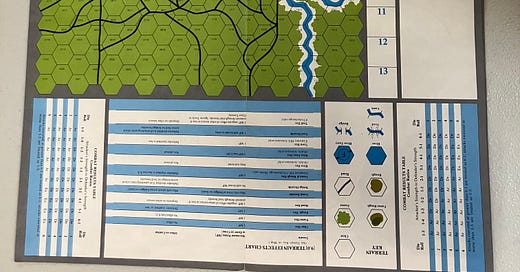In praise of older games: Shiloh
50 years later, SPI's Blue & Gray system is still worth playing
Every now and then, I read or hear someone refer to a game or a rules mechanic as “outdated” and it usually makes me furrow my brow. In some cases, I understand the usefulness of implying that a game or an aspect of a game has been superseded by more recent ideas that make for a more satisfying experience. The most common example that I see is when people call Monopoly and other roll-and-move games outdated because what happens to you is strictly limited by your die/dice roll and the space to which it takes you. Since Monopoly, mechanics that give players a wider range of options and a greater feeling of agency have been developed. Also, I remember when SPI started using hexagonal grid mapboards instead of the square, chessboard-like grids that characterized the earliest Avalon Hill wargames. It really was an improvement, as it made it easier to visualize and regulate contact between units in what was supposed to be a simulation of warfare.
Apart from those examples, however, I have a hard time seeing game design as progressive. New games don’t invalidate old games in the same way that, for instance, diesel and electric locomotives are objective improvements over steam locomotives (can you tell I’ve been dabbling in Transport Fever 2?), or even to the extent that Einstein’s Theory of Relativity replaced Newton’s clockwork Universe. New mechanics may be invented, but no matter how ingenious they are, I have almost never seen a new rule or rules system that renders what came before it obsolete. I can still go back to the best of the games that were published back in the day and find something of value in them.
Among my friends in the historical wargame community, opinion is divided about the enduring value of SPI’s body of published work. I cut my teeth on SPI games like Napoleon at Waterloo, so I have a certain sentimental attraction to the company, its legacy and its leading designers like Jim Dunnigan and the late Richard Berg. But I am also convinced that some of them have stood the test of time quite well, and I don’t get to revisit them as often as I’d like.
Keep reading with a 7-day free trial
Subscribe to "I Think We've Been Playing It Wrong" to keep reading this post and get 7 days of free access to the full post archives.




